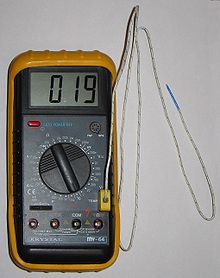
Back तापयुग्म ANP مزدوجة حرارية Arabic Termocüt Azerbaijani Тэрмапара Byelorussian Термодвойка Bulgarian Termopar BS Termoparell Catalan Termočlánek Czech Termoelement Danish Thermoelement German

| Thermoelectric effect |
|---|
 |
A thermocouple, also known as a "thermoelectrical thermometer", is an electrical device consisting of two dissimilar electrical conductors forming an electrical junction. A thermocouple produces a temperature-dependent voltage as a result of the Seebeck effect, and this voltage can be interpreted to measure temperature. Thermocouples are widely used as temperature sensors.[1]
Commercial thermocouples are inexpensive,[2] interchangeable, are supplied with standard connectors, and can measure a wide range of temperatures. In contrast to most other methods of temperature measurement, thermocouples are self-powered and require no external form of excitation. The main limitation with thermocouples is accuracy; system errors of less than one degree Celsius (°C) can be difficult to achieve.[3]
Thermocouples are widely used in science and industry. Applications include temperature measurement for kilns, gas turbine exhaust, diesel engines, and other industrial processes. Thermocouples are also used in homes, offices and businesses as the temperature sensors in thermostats, and also as flame sensors in safety devices for gas-powered appliances.
- ^ "Thermocouple temperature sensors". Temperatures.com. Archived from the original on 2008-02-16. Retrieved 2007-11-04.
- ^ Ramsden, Ed (September 1, 2000). "Temperature measurement". Sensors. Archived from the original on 2010-03-22. Retrieved 2010-02-19.
- ^ "Technical Notes: Thermocouple Accuracy". IEC 584-2(1982)+A1(1989). Retrieved 2010-04-28.